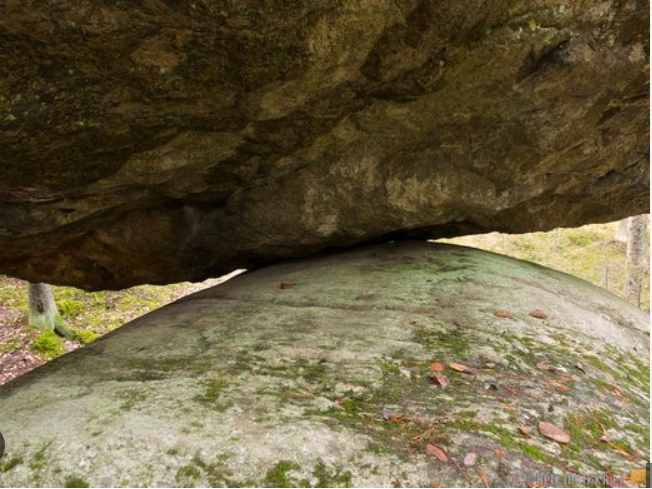
In the world, there are many self-balancing rocks in an unbelievably precarious state, such as Vaaniral Kal in India, Idol Rock in the UK, Mushroom Rock in the US, Chiremba in Zimbabwe, and Devil's Marbles.
in Australia, the Golden Rock in Burma... But perhaps the most famous is the balancing rock Kummakivi with its mysterious and unusual legends.
Kummakivi means strange rock, located in the beautiful jungle of Ruokolahti, a municipality in the South Karelia region, southeast of Finland.
In fact, Kummakivi consists of 2 rocks, one lying on the flat ground, round in shape and quite smooth, while the other has a large mass, up to 7m in length, lying precariously, stacked on top of it. strangely with the supposedly rather small touchpoint.

Upon first glance at the Kummakivi Balancing Rock, one would anticipate its upper rock to tumble off at any given moment.
Yet, against all odds, this rock remains firmly attached to the underlying bedrock, defying human efforts to push or even slightly budge it. It's unique since it remained there for millions of years while balancing. Many people made vain attempts to move it, including using explosives.
Centuries ago, the ancient inhabitants of this region were undoubtedly bewildered by the sight of this extraordinary natural phenomenon.
They must have attempted to move the Kummakivi Balancing Rock with their own hands, only to realize that their physical strength failed to dislodge the massive boulder. Consequently, they speculated that a supernatural force must have transported it to its perplexing position.

Finnish mythology is replete with tales of supernatural beings like trolls and giants, renowned for possessing physical prowess surpassing that of mere mortals.
Furthermore, these creatures have been associated with rocky landscapes. For example, Finnish folklore speaks of Hiidet, giants dwelling amidst rocky terrains, who were believed to engage in hurling boulders, constructing cairns, and carving peculiar holes in rocky outcrops (rumored to have been utilized by the giants for churning milk).
Thus, according to local mythology, one such giant or troll brought, rolled or threw the Kummakivi Balancing Rock into position.

Geologists have an alternative theory on how the Kummakivi Balancing Rock was created. It is speculated that the colossal rock was transported by glaciers during the last glacial period.
As the glaciers receded northward approximately 12,000 years ago, this rock remained behind, ultimately becoming the awe-inspiring Kummakivi Balancing Rock.
It is worth noting that the Kummakivi Balancing Rock is not an isolated example in the world. Balancing rocks, also known as precarious boulders, can be found in numerous countries, each surrounded by captivating narratives.
In India, for instance, there exists a balancing rock known as 'Krishna's Butter Ball,' a nod to an incarnation of the Hindu god Vishnu.

Beyond their ability to captivate with intriguing stories, balancing rocks have served scientific purposes as well. In the United States, researchers have employed these rocks as a form of natural seismoscope.
While they do not reveal the timing of past earthquakes, their presence indicates that the region has not experienced tremors powerful enough to dislodge them.
Understanding the force required to move these rocks can provide insights into the magnitude of past earthquakes, as well as the frequency and intervals of significant seismic events in the area.
Such information is crucial for conducting probabilistic seismic hazard analyses and, ultimately, safeguarding lives. In other words, balancing rocks have the potential to save lives!

Recognizing its significance, the rock was granted protected status in 1962.
Furthermore, it is possible that this balancing rock could prove useful for related purposes in the future, similar to how balancing rocks have been used for seismic investigations in the United States.
Read more: Canadian woman wins cheese rolling race despite being knocked unconscious




